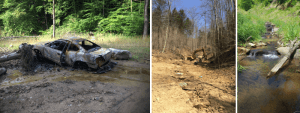DNR locks down more land for elk restoration
By Chris Lawrence | February 02, 2019 | WV MetroNews

BALTIMORE, Md. — You probably didn’t notice, but in the last several weeks the West Virginia Division of Natural Resources added even more permanent acreage to the West Virginia Elk Zone in Logan County.
Ecosystem Investment Partners of Maryland, a company which specializes in acquiring, cleaning up, and protecting land in the future to create conservation credits recently sold another 6,500 acres to the the DNR. The acreage is in two tracts, and the tract on the Tomblin Wildlife Management Area known as the Copperas Tract, constitutes 4,391 acres.
“That property and a couple of others we acquired had some legacy issues where the streams were quite degraded, but had restoration potential,” said Nick Dilks Managing Partner of EIP. “We began talking to DNR and we learned it was an area they were focused on elk restoration and public access.”
The stream work included a lot of activity to restore Copperas Branch.
“The stream was being essentially used as a road. We restored that back into a natural stream,” explained Dilks. “There were some old mine benches needing to be restored and some logging roads had been cut across the stream. We planted trees along the stream buffers to make sure the natural vegetation is back and it’s permanently protected.”
EIP makes its money through purchasing environmentally distressed property, performing reclamation, then selling the credits to companies engaged in the extraction industry. It’s a requirement for bonding and permitting through the Clean Water Act. Part of the EIP’s work means restored land no longer has any commercial value and must be protected forever. The land may not have much value on the commercial market, but it is exactly the kind of property the DNR seeks.
The agreement was part of the large, contiguous land mass of close to 35,000 acres.which is now known as the Tomblin WMA.. It was carved out ahead of the launch of the West Virginia elk restoration effort. EIP entered an original lease agreement to enable the elk restoration work on its property in southern West Virginia to move ahead. The recent.purchase completes the transaction and now the land is the sole property of the DNR and by extension, the sportsmen of West Virginia.
Dilks hopes there will be more projects with the DNR in the future. He called the partnership a win-win.
“For us to generate the credits we use in our projects, we have to permanently protect the properties. It ends up effectively reducing the value of the site. There’s no commercial use left on the property,” Dilks said. “By the very nature of what we’re doing we’re able to convey the property to the state at a much reduced price and it’s already been restored.”
The rest oft he 6,500 acres acquired by the DNR in the recent transaction is called the Oxbow Tract which has added to the acreage of the Ritchie Mines WMA in Ritchie County.
To qualify for environmental credits, restoration work has to be done in the same watershed as the work creating the disturbance. The Copperas Project was on the Guyandotte Watershed and the Oxbow Tract was in the Little Kanawha River Watershed. EIP has eight different properties in West Virginia in various states of mitigation and restoration in various watersheds of the state. Eventually more of those will likely be future WMA’s or expanded parts of existing WMA’s.
